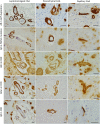Clinical considerations in early-onset cerebral amyloid angiopathy
- PMID: 37280119
- PMCID: PMC10545523
- DOI: 10.1093/brain/awad193
Clinical considerations in early-onset cerebral amyloid angiopathy
Abstract
Cerebral amyloid angiopathy (CAA) is an important cerebral small vessel disease associated with brain haemorrhage and cognitive change. The commonest form, sporadic amyloid-β CAA, usually affects people in mid- to later life. However, early-onset forms, though uncommon, are increasingly recognized and may result from genetic or iatrogenic causes that warrant specific and focused investigation and management. In this review, we firstly describe the causes of early-onset CAA, including monogenic causes of amyloid-β CAA (APP missense mutations and copy number variants; mutations of PSEN1 and PSEN2) and non-amyloid-β CAA (associated with ITM2B, CST3, GSN, PRNP and TTR mutations), and other unusual sporadic and acquired causes including the newly-recognized iatrogenic subtype. We then provide a structured approach for investigating early-onset CAA, and highlight important management considerations. Improving awareness of these unusual forms of CAA amongst healthcare professionals is essential for facilitating their prompt diagnosis, and an understanding of their underlying pathophysiology may have implications for more common, late-onset, forms of the disease.
Keywords: Alzheimer’s disease; cerebral amyloid angiopathy; dementia; early-onset; stroke.
© The Author(s) 2023. Published by Oxford University Press on behalf of the Guarantors of Brain.
Conflict of interest statement
The authors report no competing interests.
Figures





References
-
- Benson MD, Buxbaum JN, Eisenberg DS, et al. Amyloid nomenclature 2020: update and recommendations by the International Society of Amyloidosis (ISA) nomenclature committee. Amyloid. 2020;27:217–222. - PubMed
Publication types
MeSH terms
Substances
Grants and funding
LinkOut - more resources
Full Text Sources
Medical
Research Materials
Miscellaneous

